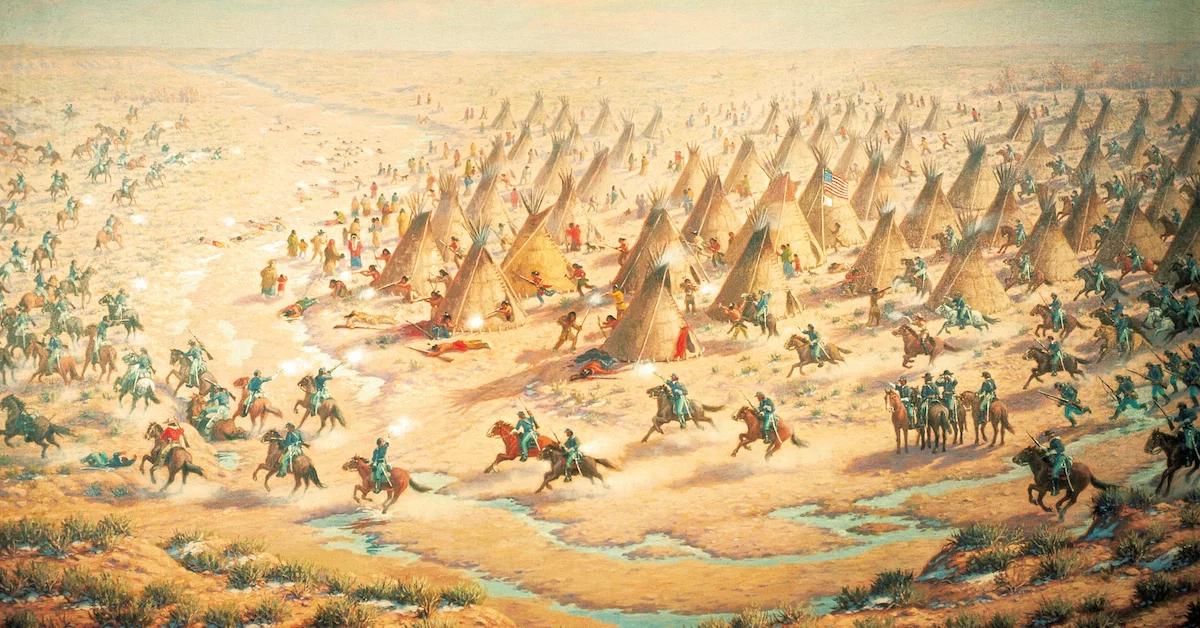About Publications Library Archives
heritagepost.org

Preserving Revolutionary & Civil War History

Preserving Revolutionary & Civil War History

Author: Joint Committee on the Conduct of the War
Date:1864
Annotation: A joint congressional committee conducted an investigation of the Sand Creek massacre and issued its report in 1864. This extract describes the events that occurred at Sand Creek.
Document: In the summer of 1864 Governor Evans of Colorado Territory…sent notice to the various bands and tribes of Indians within his jurisdiction that such as desired to be considered friendly to the whites should at once repair to the nearest military post in order to be protected from the soldiers who were to take the field against the hostile Indians….
Upon observing the approach of the soldiers, Black Kettle, the head chief, ran up to the top of his lodge an American flag…with a small white flag under it, as he had been advised to do in case he met with any troops on the prairies. Mr. Smith, the interpreter, supposing that they might be strange troops, unaware of the Indians encamped there, advanced from his lodge to meet them, but was fired upon, and returned to his lodge.
And then the scene of murder and barbarity began–men, women, and children were indiscriminately slaughtered. In a few minutes all the Indians were flying over the plain in terror and confusion. A few who endeavored to hide themselves under the bank of the creek were surrounded and shot down in cold blood, offering but feeble resistance. From the sucking babe to the old warrior, all who were overtaken were deliberately murdered. Not content with killing women and children, who were incapable of offering any resistance, the soldiers indulged in acts of barbarity of the most revolting character; such, it is to be hoped, as never before disgraced the acts of men claiming to be civilized. No attempt was made by the officers to restrain the savage cruelty of the men under their command, but they stood by and witnessed these acts without one word of reproof, if they did not incite their commission. For more than two hours the work of murder and barbarity continued, until more than one hundred dead bodies, three fourths of them women and children, lay on the plain as evidences of the fiendish malignity and cruelty of the officers who had so sedulously and carefully plotted the massacre, and of the soldiers who had so faithfully acted out the spirit of their officers….
It is true that there seems to have existed among the people inhabiting that region of country a hostile feeling towards the Indians. Some of the Indians had committed acts of hostility towards the whites; but no effort seems to have been made by the authorities there to prevent these hostilities, other than by the commission of even worse acts. The hatred of the whites to the Indians would seem to have been inflamed and excited to the utmost; the bodies of persons killed at a great distance–whether by Indians or not, is not certain–were brought to the capital of the Territory and exposed to the public gaze for the purpose of inflaming still more the already excited feeling of the people. Their cupidity was appealed to, for the governor in a proclamation calls upon all, “either individually or in such parties as they may organize,” “to kill and destroy as enemies of the country, wherever they may be found, all such hostile Indians,” authorizing them to “hold to their own private use and benefit all the property of said hostile Indians that they may capture.”
Source: 39th Congress, 2nd Session, U.S. Senate, Reports of Committees, No. 156.